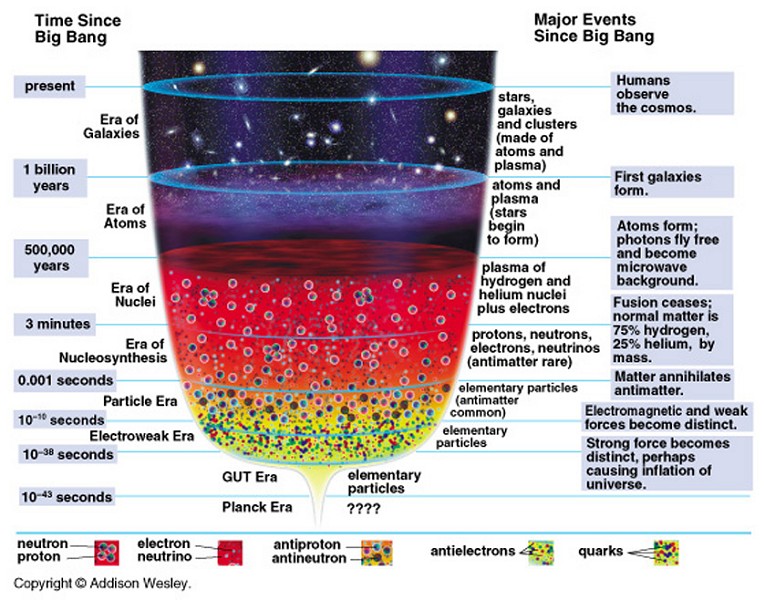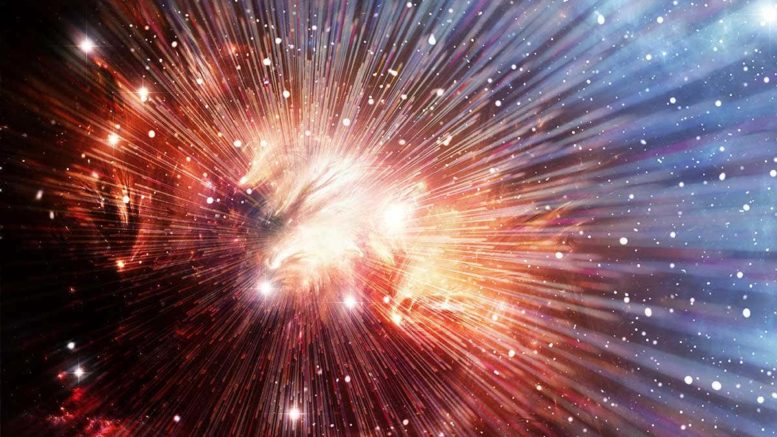The Big Bang theory is a cosmological model for the observable universe from the earliest known periods through its subsequent large-scale evolution. The model describes how the universe expanded from a very high-density and high-temperature state, and offers a comprehensive explanation for a broad range of phenomena, including the abundance of light elements, the cosmic microwave background (CMB), large-scale structure and Hubble’s law.
English astronomer Fred Hoyle is credited with coining the term “Big Bang” during a 1949 BBC radio broadcast, saying: “These theories were based on the hypothesis that all the matter in the universe was created in one big bang at a particular time in the remote past.”
Development of Big Bang Theory
Written by Robert Grosseteste , the 1225 treatise De Luce, meaning On Light, explored the nature of matter and the cosmos. In this treatise, he described the birth of the universe in an explosion and the crystallization of matter to form stars and planets in a set of nested spheres around Earth. This is important because this is the first attempt to describe the heavens and Earth using a single set of physical laws.
In 1610, Johannes Kepler used the dark night sky to argue for a finite universe. In 1687, 77 years after Kepler argued for a finite universe, Isaac Newton described large-scale motion throughout the universe. In 1912, Vesto Slipher measured the first Doppler shift of a “spiral nebula,” and soon discovered that almost all such nebulae were receding from Earth. Please note that the term spiral nebula above is the obsolete term for spiral galaxies.
In 1922 Russian scientist Alexander Friedmann derived the Friedmann equations from Albert Einstein’s equations of general relativity. These equations definitively showed that the universe might be expanding in contrast to the static universe model advocated by Einstein at that time. In 1924 Edwin Hubble’s measurement of the great distance to the nearest spiral nebulae showed that these systems were indeed other galaxies. In 1927, Georges Lemaître independently derived the Friedmann equations and then proposed that the inferred recession of the nebulae was due to the expansion of the universe. Going a step further, in 1931 Lemaître suggest that using the expansion of the universe, one could project that further back in the past, there was a finite time in which all the mass of the universe was concentrated into a single point, a “primeval atom” where and when the fabric of time and space came into existence.
Post World War II science surrounding the origin of the universe saw two distinct possibilities emerge. The first was Fred Hoyle’s steady state model, which said that new matter would be created as the universe seemed to expand. Therefore, the universe can be interpreted as roughly the same at any point in time.
The alternative was the Big Bang theory proposed by Lemaître, which would be advocated and further developed by George Gamow. It was George Gamow, who introduced the idea of Big Bang nucleosynthesis and his whose associates, Ralph Alpher and Robert Herman, predicted the CMB, Cosmic Microwave Background. The 1964 discovery and confirmation of the CMB secured the Big Bang as the best theory of the origin and evolution of the universe. Published papers by scientists in 1968 and 1970 showed that mathematical singularities were an inevitable initial condition of general relativistic models of the Big Bang. Moving forward, cosmologists would further research the characterizing the features of the Big Bang universe and resolving outstanding problems. In 1981, Alan Guth made a breakthrough in theoretical work on resolving certain outstanding theoretical problems in the Big Bang theory with the introduction of an epoch of rapid expansion in the early universe he called “inflation.”
Timeline of the Big Bang
The following photo is a great explanation of what happened during each step of the Big Bang. It was found at https://www.physicsoftheuniverse.com/topics_bigbang_timeline.html

Observational evidence
- Hubble’s Law And The Expansion Of Space have found that objects observed in deep space are found to have a redshift, interpreted as a relative velocity away from Earth; as these doppler shift-measured velocity is approximately proportional to their distance from the Earth for galaxies. This has shown that galaxies and space is expanding.
- Cosmic Microwave Background Radiation is electromagnetic radiation remnant from an early stage of the universe, which is faint cosmic background radiation filling all space. It is an important source of data on the early universe because it is the oldest electromagnetic radiation in the universe, dating to the epoch of recombination.
- Abundance Of Primordial Elements have shown that measured abundances at least roughly align with the predictions in regards to the concentration of helium-4, helium-3, deuterium, and lithium-7 in the universe as ratios to the amount of ordinary hydrogen.
- Galactic Evolution And Distribution has shown that the morphology and distribution of galaxies and quasars are in agreement with the current state of the Big Bang theory. A combination of observations and theory suggest that the first quasars and galaxies formed about a billion years after the Big Bang, and since then, larger structures have been forming, such as galaxy clusters and superclusters.
- Primordial gas clouds were found in 2011 that contained no elements heavier than hydrogen and deuterium, which were likely formed during the first few minutes after the Big Bang
Problems with the big bang
- Baryon Asymmetry, which is the observed imbalance in baryonic matter (the type of matter experienced in everyday life) and antibaryonic matter in the observable universe.
- Dark Energy accounts for 73% of the matter in the universe. Dark energy solves many issues in regards to the age and mass of the universe as general relativity requires that much of the energy in the universe consists of a component with large negative pressure.
- Dark Matter accounts for 23% of matter helps explain the observations that showed that there was not sufficient visible matter in the universe to account for the apparent strength of gravitational forces within and between galaxies.
- Horizon Problem, which arises due to the difficulty in explaining the observed homogeneity of causally disconnected regions of space in the absence of a mechanism that sets the same initial conditions everywhere.
- Magnetic Monopoles, which were raised in the late 1970s by the Grand unified theory predicted topological defects in space that would manifest as magnetic monopoles. This problem was resolved by cosmic inflation, which removes all point defects from the observable universe, in the same way that it drives the geometry to flatness.
- Flatness Problem helps to determine spatial curvature depending on the total energy density of the universe.
References and Further Reading
https://en.wikipedia.org/wiki/Big_Bang
https://www.joh.cam.ac.uk/library/special_collections/hoyle/exhibition/radio/
https://map.gsfc.nasa.gov/universe/bb_theory.html
https://science.nasa.gov/astrophysics/focus-areas/what-powered-the-big-bang/
https://www.science20.com/hammock_physicist/big_bang_big_bewilderment
https://curlie.org/Science/Astronomy/Cosmology/
https://www.britannica.com/science/big-bang-model
Books:
- Alpher, R. A.; Herman, R. (1988). “Reflections on Early Work on ‘Big Bang’ Cosmology”. Physics Today. 41 (8): 24–34. Bibcode:1988PhT….41h..24A. doi:10.1063/1.881126.
- “Cosmic Journey: A History of Scientific Cosmology”. American Institute of Physics.
- Barrow, J. D. (1994). The Origin of the Universe. Weidenfeld & Nicolson. ISBN 978-0-297-81497-9.
- Feuerbacher, B.; Scranton, R. (2006). “Evidence for the Big Bang”. TalkOrigins.
- Lineweaver, Charles H.; Davis, Tamara M. (March 2005). “Misconceptions about the Big Bang” (PDF). Scientific American. pp. 36–45.
- Mather, J. C.; Boslough, J. (1996). The Very First Light: The True Inside Story of the Scientific Journey Back to the Dawn of the Universe. Basic Books. p. 300. ISBN 978-0-465-01575-7.

Be the first to comment on "The Big Bang Theory"